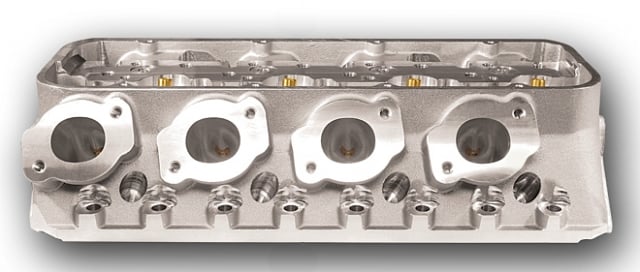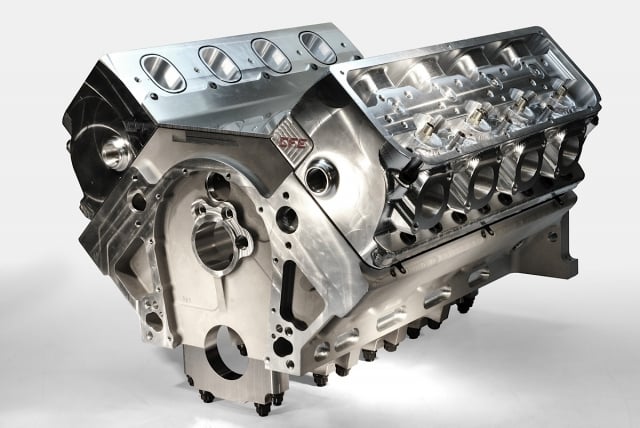 EngineLabs just learned that CFE Racing Products has broken the 600-cubic-inch barrier for small-block Chevy engines.
EngineLabs just learned that CFE Racing Products has broken the 600-cubic-inch barrier for small-block Chevy engines.
The Michigan-based company, which specializes in racing cylinder head development, is currently ready to ship the foundation components — cylinder block, cylinder heads and intake manifold — with the necessary dimensions to support a 600ci displacement within the somewhat traditional confines of the 58-year-old SBC platform.
“In all practical purposes, it’s a next-generation small-block,” CFE’s Larry Gadette tells EngineLabs. “It’s what Chevrolet should’ve done 20 years ago.”
The project is so new that information remains limited, and only one photo is available. EngineLabs will update this story as more news is released, hopefully in the coming week.
The new 600ci architecture is an extension of the current big-inch efforts that have escalated in recent years with improved billet-block design and machining techniques. Aftermarket engineers can now enlarge dimensions and map out near perfect geometries and clearances, then program that data into a CNC machine and produce perfectly aligned blocks and cylinder heads.
“We really didn’t start out to develop a 600-incher,” explains Gadette. “We started developing a 572ci engine that was more proportional and conducive to making high-end power.”
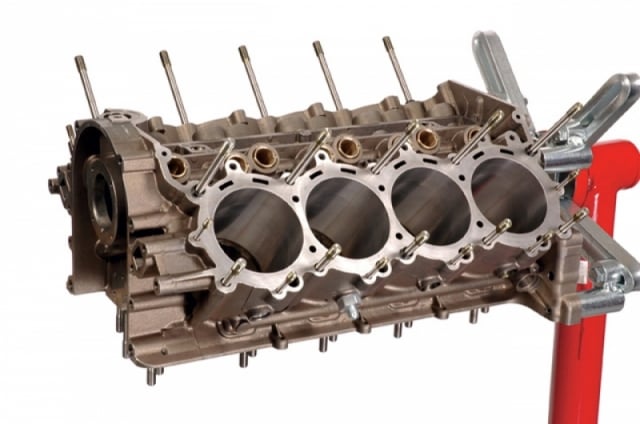
Here’s the GM R07 cylinder block with 4.5-inch bore spacing and improved cooling dynamics. It helped pave the way for aftermarket blocks with with bore spacing stretched over the traditional 4.400-inch standard.
The original customer wanted a big-inch engine based off a block with 4.5-inch bore spacing. He already had a crankshaft with a 4.900-inch stroke.
“We started doing some research and thought, if he’s got a 4.900-inch arm, all we need is a little more bore and we’ve got 600 cubic inches,” says Gadette. “It was spawned from that.”
Concluding that a number of markets would salivate over 600ci — which equates to 9.83 liters — CFE moved forward on designing a block with 4.6-inch bore centers and expanding its famed SBX cylinder head to support the wider cylinder locations.
“It’s only .475-inch longer than a traditional small-block,” reports Gadette. “It fits where a small-block fits and it looks like a small block.”
The block, which can ordered with or without water jackets, sports a 4.400-inch bore. When combined with a 4.900-inch-stroke crankshaft, the resulting displacement is 596ci, but it’s possible to poke out the cylinders to 4.500 inches.
“The bore size will support 662ci,” says Gadette. “So it’s almost possible to reach 700!”
Always looking to go bigger
Hot rodders have been trying to hog out the small-block Chevy since the ‘70s when they were squeezing 4.0-inch stroker cranks into a stock 400 block to get 434ci. The problem, of course, was rod clearance against the cylinders and camshaft. The aftermarket addressed these issues with newer blocks that raised the cam and provided side clearance.
Displacements continued to creep up, but the next milestone came in 1994 when Sonny Leonard built the first 500ci small block.
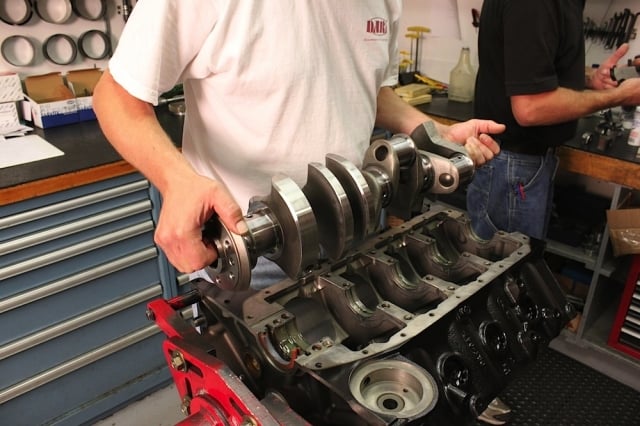
Hot rodders have always tried to boost displacement with stroker cranks in the small-block Chevy, but kept running into interference with the rails and camshaft.
“560ci is about as big as you can get with the small-block,” says Gadette. “Then you can get a real clumsy engine.”
Blocks stretched out for 4.5-inch bore centers became the norm for big-cube small-blocks when NASCAR approved Chevy’s R07 race engine, which replaced the venerable SB2 engine. For the current generation of 358ci engines, NASCAR allows 4.5-inch bore centers but restricts the maximum bore to 4.185. The extra distance between cylinders give engineers more room to circulate coolant — in other words, no need for siamese cylinders and more durability.
“People don’t realize the SB2 head was developed into a 4.5-inch platform (called the R03 head) but abandoned in favor of the R07,” says Gadette.
The stock deck height on a Chevy small-block is 9.025 inches, but the aftermarket has taken its blocks up to 9.500 inches — with some specialty billet applications going as tall as 10.2 inches. The CFE block is set at 10.0 inches.
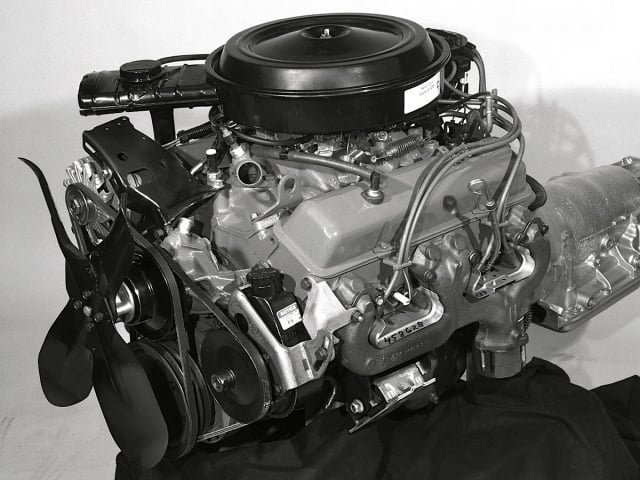
Here’s the 400ci Chevy from the ’70s. It was the best factory option to go big, but the largest displacement realistically possible was 434ci.
“Of course, we could make it 12 inches, if we wanted,” boasts Gadette. “But then you start getting really weird rod-length ratios. At some point you have to call it quits.”
The CFE block retains the standard Chevy bellhousing pattern and 4-bolt steel main caps (stock 400 journal size); plus the familiar horse-collar timing-cover boss/water jacket holes on the front appears similar to the standard small-block. Other features following tradition include standard Chevy engine-mount locations, available distributor accommodation and oil-pan rail dimensions similar to the famed Rocket block, which was an Oldsmobile version of the SBC used in drag racing and provided wider oil pans for stroker clearance and also a raised cam location.
“You can even bolt a regular Chevy water pump to this block,” says Gadette.
Some familiar SBC cues, some new
Outside of the familiar Chevy cues, the CFE block will have .937 lifter bores and will not offer a provision for a mechanical fuel pump. The cam location is “standard big-block plus .400,” and the block will support 55mm roller-cam bearings and 60mm babbit.
CFE stretched out a version of its SBX head, which was developed for the Chevy Pro Stock trucks in the ‘90s, to fit the 4.6 bore centers — a move that opens up considerable airflow possibilities.
“You’ve never been able to get a 2.300 intake in a small-block head. There’s not enough room for it,” says Gadette. “Now there is.”
The 600ci SBX head will hold a 2.300/1.900 combination, which was certainly unheard of just a few years ago. Think about it, a standard 454 big-block Chevy has 2.19/1.88 valves, and the popular Victor Jr. BBC head comes with 2.25/1.90 valves.
CFE will not sell the 600ci components to the general public. A select group of builders has been approved to distribute the engine. They will get only the block, heads and dedicated intake manifold, which can support a variety of carb and fuel-injection setups. The builders then work with their favorite suppliers for the rotating assembly, wet- or dry-sump oiling, induction and accessories.
There are limitations to such a large displacement in a small-block, particularly due to the under-square bore/stroke ratio that complicates frictional losses. However, the total potential for this new engine platform hasn’t been fully explored yet. Gadette says the deck height could be trimmed down to 8.75 inches, giving engine builders for Bonneville-type vehicles or even Pro Mods the potential for an over-square bore/stroke ratio and much higher-revving capabilities — especially with boost.
“It’s such a universal project with implications for performance, such as those looking for the most horsepower from a small-block, or those looking for something cool in a show car,” sums up Gadette. “Whatever direction you want to take it, there’s definitely room for it to be a game changer.”



